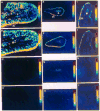The vasoprotective axes of the renin-angiotensin system: Physiological relevance and therapeutic implications in cardiovascular, hypertensive and kidney diseases
- PMID: 28619367
- PMCID: PMC5607101
- DOI: 10.1016/j.phrs.2017.06.005
The vasoprotective axes of the renin-angiotensin system: Physiological relevance and therapeutic implications in cardiovascular, hypertensive and kidney diseases
Abstract
The renin-angiotensin system (RAS) is undisputedly one of the most prominent endocrine (tissue-to-tissue), paracrine (cell-to-cell) and intracrine (intracellular/nuclear) vasoactive systems in the physiological regulation of neural, cardiovascular, blood pressure, and kidney function. The importance of the RAS in the development and pathogenesis of cardiovascular, hypertensive and kidney diseases has now been firmly established in clinical trials and practice using renin inhibitors, angiotensin-converting enzyme (ACE) inhibitors, type 1 (AT1) angiotensin II (ANG II) receptor blockers (ARBs), or aldosterone receptor antagonists as major therapeutic drugs. The major mechanisms of actions for these RAS inhibitors or receptor blockers are mediated primarily by blocking the detrimental effects of the classic angiotensinogen/renin/ACE/ANG II/AT1/aldosterone axis. However, the RAS has expanded from this classic axis to include several other complex biochemical and physiological axes, which are derived from the metabolism of this classic axis. Currently, at least five axes of the RAS have been described, with each having its key substrate, enzyme, effector peptide, receptor, and/or downstream signaling pathways. These include the classic angiotensinogen/renin/ACE/ANG II/AT1 receptor, the ANG II/APA/ANG III/AT2/NO/cGMP, the ANG I/ANG II/ACE2/ANG (1-7)/Mas receptor, the prorenin/renin/prorenin receptor (PRR or Atp6ap2)/MAP kinases ERK1/2/V-ATPase, and the ANG III/APN/ANG IV/IRAP/AT4 receptor axes. Since the roles and therapeutic implications of the classic angiotensinogen/renin/ACE/ANG II/AT1 receptor axis have been extensively reviewed, this article will focus primarily on reviewing the roles and therapeutic implications of the vasoprotective axes of the RAS in cardiovascular, hypertensive and kidney diseases.
Keywords: ACE2; Alamandine; Angioprotectin; Angiotensin (1–7); Angiotensin 1-converting enzyme; Angiotensin II; Cardiovascular disease; Dipeptidyl peptidase III; Hypertension.
Copyright © 2017 Elsevier Ltd. All rights reserved.
Figures





References
-
- de Gasparo M, Catt KJ, Inagami T, Wright JW, Unger T International union of pharmacology. XXIII. The angiotensin II receptors. Pharmacol Rev. 2000;52(3):415–472. - PubMed
-
- Coffman TM. Under pressure: the search for the essential mechanisms of hypertension. Nat Med. 2011;17(11):1402–1409. - PubMed
-
- Kobori H, Nangaku M, Navar LG, Nishiyama A. The intrarenal renin-angiotensin system: from physiology to the pathobiology of hypertension and kidney disease. Pharmacol Rev. 2007;59(3):251–287. - PubMed
-
- Carey RM, Siragy HM. Newly recognized components of the renin-angiotensin system: potential roles in cardiovascular and renal regulation. Endocr Rev. 2003;24:261–271. - PubMed
Publication types
MeSH terms
Grants and funding
LinkOut - more resources
Full Text Sources
Other Literature Sources
Medical
Research Materials
Miscellaneous

